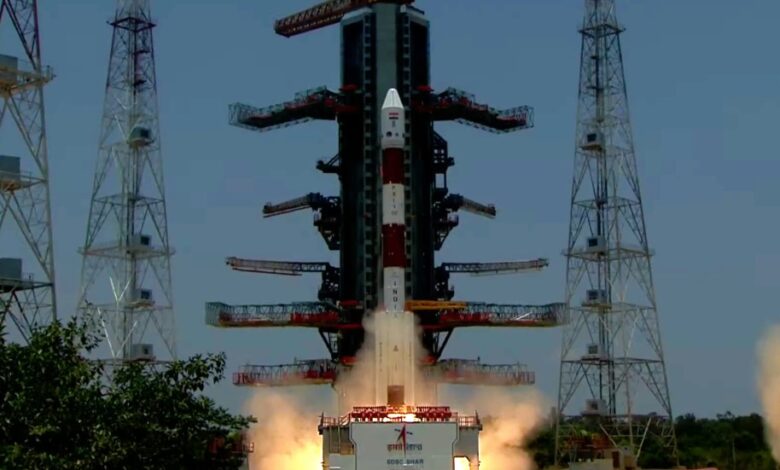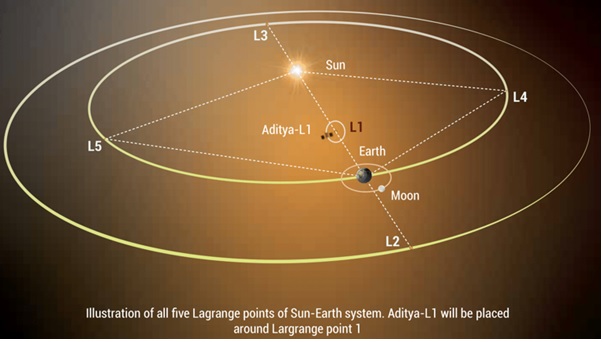India’s Aditya-L1 solar mission has achieved a successful launch

New Delhi: India’s Aditya-L1 solar mission has triumphantly taken flight on its historic journey toward the Sun. This ambitious space endeavor is dedicated to studying our nearest star, the Sun, with the goal of unveiling valuable insights into its behavior and its influence on Earth’s environment. The successful launch stands as a remarkable milestone in India’s relentless pursuit of scientific exploration in space through the Aditya-L1 solar mission.
Named Aditya-L1, the spacecraft embarked on its remarkable journey, boasting a weight of over 3,264 pounds. The launch took place at the renowned Satish Dhawan Space Centre, situated in South India’s Sriharikota. It was propelled into space using the towering 44.4-meter tall polar satellite launch vehicle (PSLV-XL) with precision, aligning with the scheduled departure time of 11:50 am local time on a Saturday.
Aditya-L1 is now set to embark on an extraordinary voyage, covering an extensive distance of 932,000 miles. This remarkable journey will span over 125 days, which equates to slightly over four months. The destination that Aditya-L1 aims to reach is equally impressive: a halo orbit encircling one of the five Lagrangian points. These points strategically position themselves between the Sun and Earth, offering a unique vantage point for spacecraft to continuously monitor solar activities. This positioning ensures an uninterrupted view, free from any occultation and eclipse, enabling Aditya-L1 to carry out its critical mission to study the Sun.
India’s premier space agency, the Indian Space Research Organization (ISRO), has orchestrated an impressive scientific ensemble on board the Aditya-L1 spacecraft. This suite comprises seven essential payloads, strategically divided into four for remote sensing purposes and three for conducting vital on-site experiments.
Among the onboard instruments, a visible emission line coronagraph stands out, designed to provide crucial insights into the Sun’s outer atmosphere. The solar ultraviolet imaging telescope will capture the Sun’s ultraviolet emissions, while the X-ray spectrometer will enable detailed X-ray analysis. To further enhance its data-gathering capabilities, Aditya-L1 is equipped with a solar wind particle analyzer, a plasma analyzer package, and tri-axial high-resolution digital magnetometers.
India’s Next Bold Step: Unveiling the Aditya Solar Mission for a Sun-bound Journey this September.
The overarching objective of this mission, known as PSLV-C57, is to engage in real-time observations of solar activities and their profound influence on space weather. By meticulously studying and understanding these solar dynamics, the Aditya-L1 solar mission aspires to provide invaluable insights into this celestial body’s behavior and its repercussions on our surrounding cosmic environment.
Following a journey lasting over an hour from liftoff, the PSLV executed a precise maneuver, injecting the Aditya-L1 spacecraft into an elliptical orbit with dimensions of 146 miles at its closest approach and an impressive 12,117 miles at its farthest point from Earth. Notably, this marked the inaugural occasion when the launch vehicle’s upper stage employed two distinct burn sequences to ensure the spacecraft reached its intended orbit with precision and accuracy.
ISRO Chairman S. Somanath expressed his congratulations to the PSLV team for their innovative mission approach during the launch of Aditya-L1. Speaking from the space agency’s mission control center, he stated, “Today, the PSLV has demonstrated a unique mission approach to successfully position the Aditya-L1 spacecraft in its designated orbit. Following this, Aditya-L1 will embark on its journey after executing specific Earth maneuvers. Let us extend our best wishes to the Aditya spacecraft as it embarks on its extended journey, ultimately reaching its destination within the halo orbit of L1.”
The instruments aboard the Aditya-L1 spacecraft have been meticulously designed to investigate and study the Sun’s three critical components: the photosphere, the chromosphere, and the corona. Additionally, the trio of instruments dedicated to on-site experiments will be focused on observing the immediate environment surrounding the Lagrangian point L1. This comprehensive approach will provide a deeper understanding of the Sun’s various layers and their influence on our solar system.
Useful 16 Kitchen Gadgets for Healthy Living and Eating

The Aditya-L1 solar mission, which received an allocation of approximately $46 million from the Indian government in 2019, was initially conceived back in 2008 with the primary objective of scrutinizing the solar corona, the Sun’s outermost layer of the atmosphere. This significant undertaking was aptly named “Aditya,” a term that signifies “sun” in Hindi, reflecting its dedication to solar exploration.
However, as the mission evolved and expanded in scope, the Indian Space Research Organization (ISRO) made the strategic decision to rename it “Aditya-L1.” This nomenclature change was reflective of the mission’s broader mission objectives, encompassing the study of not only the solar corona but also the intricate solar and space environments. By encompassing this wider perspective, Aditya-L1 has positioned itself as a comprehensive solar mission with the potential to unveil a multitude of scientific insights into our closest star, the Sun.
“The realization of this mission is truly a dream come true for the Aditya-L1 team,” expressed Nigar Shaji, the project director for the Aditya-L1 mission. She added, “Upon the commissioning of the Aditya mission, it will undoubtedly serve as a valuable asset to the field of heliophysics within our nation and contribute significantly to the global scientific community.”
Historically, space agencies such as those in the U.S., Europe, and China have undertaken missions dedicated to solar observation in outer space. Remarkably, this marks India’s debut in this domain, representing the first instance of the country venturing into space for solar research. Previously, India had primarily concentrated its solar observation efforts utilizing ground-based telescopes.
The Indian space agency garnered global attention and acclaim just last week with the successful soft landing of Chandrayaan-3 on the lunar surface. In a recent development, ISRO released a video shared by the mission’s lander, revealing the rover’s movement on the moon’s surface as it navigates to identify a secure route. This lunar mission is instrumental in conducting a series of experiments aimed at facilitating future human landings on the lunar terrain.
“As the entire world watched with eager anticipation, this achievement marks a radiant moment for India,” stated Jitendra Singh, the Deputy Minister for Science and Technology, as he extended his heartfelt congratulations to ISRO for the triumphant launch of the Aditya-L1 mission.
In parallel with the Aditya-L1 mission, ISRO has been diligently advancing its endeavors in the realm of human space flight, with the ambitious Gaganyaan mission on the horizon, set for 2025. Simultaneously, ISRO is actively exploring the launch of an unmanned mission to the planet Venus, showcasing the agency’s relentless pursuit of cutting-edge space exploration initiatives.
In June, India formalized its participation as a signatory of NASA’s Artemis Accords, solidifying its commitment to collaborative space exploration ventures with partner nations. This collaborative effort involves NASA’s pledge to provide training for Indian astronauts at the renowned Johnson Space Center in Houston, with plans to facilitate their journey to the International Space Station in the coming year. Furthermore, ISRO and NASA have embarked on a joint mission, scheduled for launch in 2024, focused on establishing a low-Earth observatory. This mission aims to comprehensively map the entire planet within a mere 12-day span, consistently monitoring Earth’s vital ecosystems, ice mass, vegetation biomass, sea levels, and the occurrences of natural disasters and hazards.
Furthermore, earlier this year, India unveiled a comprehensive space policy aimed at enhancing private sector involvement in its space endeavors. This strategic move is geared towards fostering a thriving ecosystem for private participation in space missions. Notably, India is already home to a burgeoning community of over 150 space technology startups dedicated to the development of launch vehicles, satellite technology, and innovative Earth observatory solutions.
Notably, in the realm of Indian space technology startups, funding witnessed a substantial 17% surge, rising from $96 million in 2021 to a noteworthy $112 million in 2022. Moreover, the space tech sector experienced a remarkable upswing, with a staggering 60% increase in capital infusion, soaring to $62 million in 2023, as revealed by recent data from analyst firm Tracxn.
These upward trends signify a growing appetite for investments in Indian startups dedicated to space technology. Notably, the potential for further expansion in this sector is on the horizon, given the anticipated relaxation of norms governing foreign direct investments—a development long advocated for by various stakeholders within the industry. This favorable climate bodes well for the continued growth and innovation within India’s burgeoning space technology startup ecosystem, coinciding with the advancements made through the Aditya-L1 solar mission.
If you are interested in space and want to see stars and other planets then here are some best cameras for you
If you’re passionate about stargazing and capturing celestial beauty, having the right camera is crucial. Whether you’re an amateur astronomer, astrophotographer, or simply love the night sky, here are some top cameras for your cosmic adventures.
An astronomy camera, often known as an astrophotography camera, is specifically designed for capturing celestial objects and events in the night sky. These cameras come equipped with features like low-light sensitivity, long exposure capabilities, and often have cooled sensors to reduce noise during long exposures. They are used by astronomers and astrophotographers to capture stunning images of stars, planets, galaxies, and other cosmic phenomena.
1. ZWO ASI294MC Pro: This camera is popular for its large sensor, low noise, and impressive sensitivity, making it suitable for deep-sky astrophotography.

2. Sony Alpha a7: While not designed exclusively for astronomy, this full-frame mirrorless camera boasts excellent low-light performance and 4K video capabilities, making it versatile for astrophotography and other photography genres.

3. Canon EOS Ra: Designed with astrophotography in mind, this full-frame camera has a modified infrared filter, making it excellent for capturing nebulae and other deep-sky objects.

4. Celestron NexImage 10MP: Ideal for planetary imaging, this camera is designed for use with telescopes and provides high-resolution images of planets like Jupiter and Saturn.

Remember, the “best” camera for you depends on your specific goals and budget. Additionally, consider the compatibility of the camera with your telescope or equipment, as well as any additional accessories you may need for astrophotography.





